OCZ Vertex Plus Preview: Introducing the Indilinx Martini
by Anand Lal Shimpi on November 16, 2010 9:31 AM EST- Posted in
- Storage
- SSDs
- OCZ
- Indilinx Martini
- Intrepid
Overall System Performance using PCMark Vantage
Next up is PCMark Vantage, another system-wide performance suite. For those of you who aren’t familiar with PCMark Vantage, it ends up being the most real-world-like hard drive test I can come up with. It runs things like application launches, file searches, web browsing, contacts searching, video playback, photo editing and other completely mundane but real-world tasks. I’ve described the benchmark in great detail before but if you’d like to read up on what it does in particular, take a look at Futuremark’s whitepaper on the benchmark; it’s not perfect, but it’s good enough to be a member of a comprehensive storage benchmark suite. Any performance impacts here would most likely be reflected in the real world.
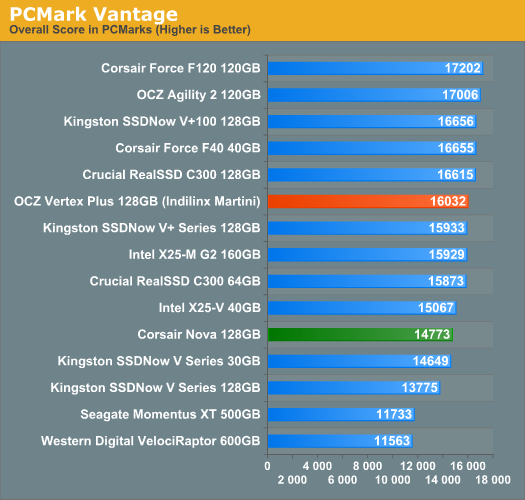
Light usage performance as represented by PCMark Vantage is about 9% faster compared to the old Indilinx Barefoot. The Martini controller looks and acts like a modern SSD controller.
The memories suite includes a test involving importing pictures into Windows Photo Gallery and editing them, a fairly benign task that easily falls into the category of being very influenced by disk performance.
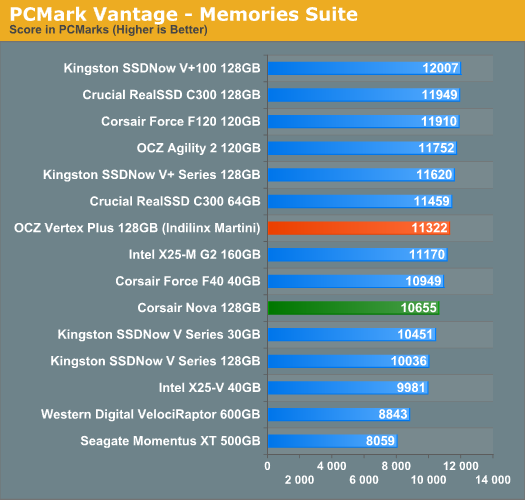
The TV and Movies tests focus on on video transcoding which is mostly CPU bound, but one of the tests involves Windows Media Center which tends to be disk bound.
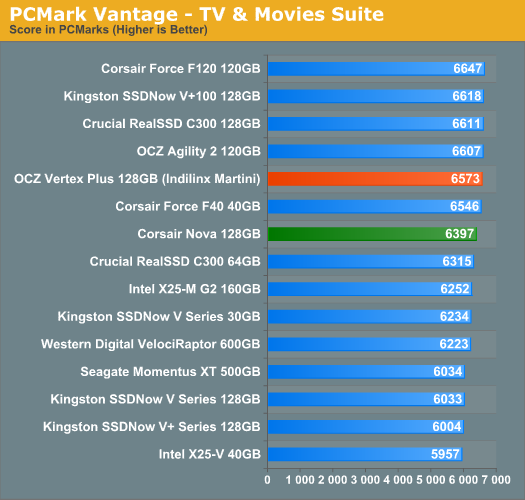
The gaming tests are very well suited to SSDs since they spend a good portion of their time focusing on reading textures and loading level data. All of the SSDs dominate here, but as you'll see later on in my gaming tests the benefits of an SSD really vary depending on the game. Take these results as a best case scenario of what can happen, not the norm.
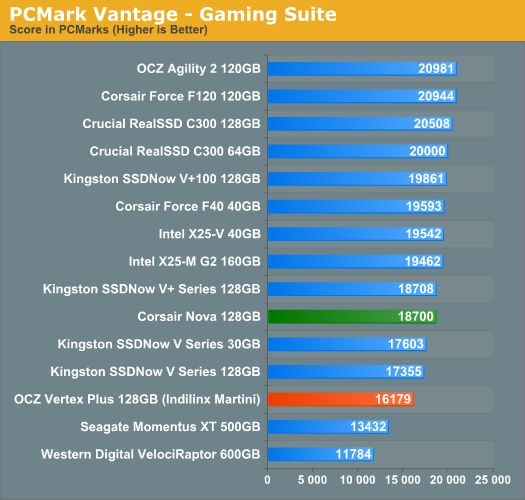
In the Music suite the main test is a multitasking scenario: the test simulates surfing the web in IE7, transcoding an audio file and adding music to Windows Media Player (the most disk intensive portion of the test).
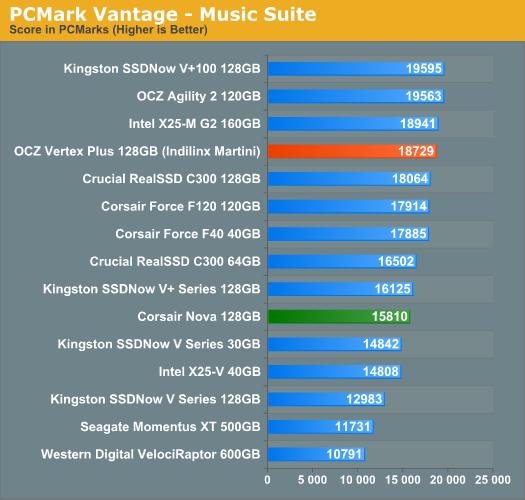
The Communications suite is made up of two tests, both involving light multitasking. The first test simulates data encryption/decryption while running message rules in Windows Mail. The second test simulates web surfing (including opening/closing tabs) in IE7, data decryption and running Windows Defender.
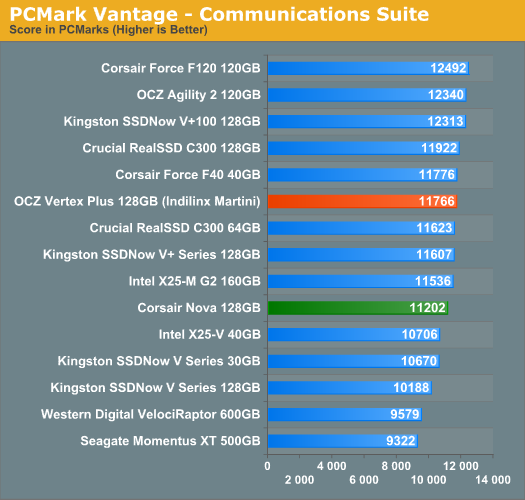
I love PCMark's Productivity test; in this test there are four tasks going on at once, searching through Windows contacts, searching through Windows Mail, browsing multiple webpages in IE7 and loading applications. This is as real world of a scenario as you get and it happens to be representative of one of the most frustrating HDD usage models - trying to do multiple things at once. There's nothing more annoying than trying to launch a simple application while you're doing other things in the background and have the load take forever.
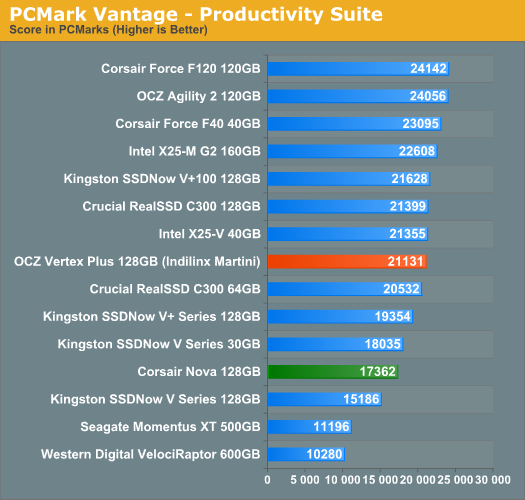
The final PCMark Vantage suite is HDD specific and this is where you'll see the biggest differences between the drives:
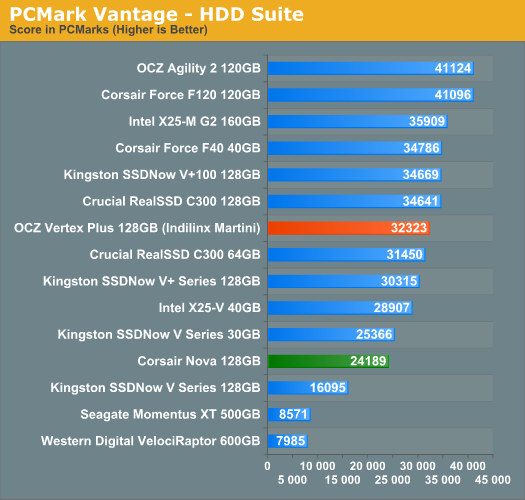










61 Comments
View All Comments
leexgx - Tuesday, November 16, 2010 - link
i agree 128gb would seem to be the min i would getgot the 256gb m225 my self before the £100 price increase i have 50gb free on that, i had an corsair s128 before that bit slow at writing but load times was quite fast, main thing that went faster was disk based installs like stream pre load decrypt (when you pre load an steam game its encrypted it has to decrypt Very disk intensive as it has to read and write a lot) as it would make my corsair S128 stall the system for short times as latency's whent up to 1000, m225 system is fully usable when it was decrypting blackops
apart from jmicron and older samsung first-second gen ssds, you be hard pressed to notice the difference unless you was doing server loads (like if i went from an m225 to an sf-1200 based ssd my pc mite boot up 1 second faster same goes for games and programs)
only reason you see me replacing this ssd is if i was getting an 512gb version (like i got money to burn :) ) or 2xSF-1200 based ssd's in raid 0 (as GC works good on them)
the segate XT drives may not seem that good but if your mainly only playing games or opening the same files often you could raid 3-4 of them in RAID 0 and that give you 16gb of cache data to work with
iamezza - Wednesday, November 17, 2010 - link
I would consider myself a power user, I spend much of the day on my PC working then later for gaming and I get by just fine with an 80GB SSD. I am currently using less than half capacity. Moving the user files in Windows 7 is a piece of piss, takes about 5mins and then its done, it's just drag and drop onto your storage drive.The only thing I can't do is install my games directory onto an SSD even a 128GB wouldn't be enough for that.
I recently installed a 30GB SSD into my HTPC and it works a treat. Being a HTPC everything apart from the OS goes onto a storage drive so 30GB is more than enough.
Mugur - Thursday, November 18, 2010 - link
You are right, regarding this particular case, but I can see from other small drives, like Corsair F40, Intel X25-V 40 GB etc. how the performance scales down... F40 looks almost similar to F120 and we all know with Intel 40 GB that they have half channels so the sequential write is the most affected, not so much other factors.Crucial - Tuesday, November 16, 2010 - link
All these reviews keep making me happy with my purchase of the 128mb Crucial drive. It seems to be a solid all around performer that still stays towards the top of the heap.Mr Perfect - Tuesday, November 16, 2010 - link
Not to divert this nifty SSD article, but if the drive manufacturers are so dead set on using round, metric numbers for their bytes, then I think I'm going to start calling them Metric Gigabytes and Imperial Gigabytes. It follows the current naming schemes much better then these ridiculous gibibytes. Who came up with that name anyhow?akedia - Tuesday, November 16, 2010 - link
*sighs*The prefix giga- is metric, while the prefix gibi- is binary. Your phrase "metric gigabyte" is redundant, while your "imperial gigabyte" is nonsensical.
A Gigabyte is 10^9, or 1,000,000,000, bytes. https://secure.wikimedia.org/wikipedia/en/wiki/Gig...
A Gibibyte is 2^30, or 1,073,741,824, bytes. https://secure.wikimedia.org/wikipedia/en/wiki/Gib...
Using the word gigabyte for those nice, round numbers is correct. The problem is operating system manufacturers whose systems display the number in the form of gibibytes. I'm not sure about others, but OS X now correctly displays gigabytes, erasing the apparent (but not actual) discrepancy between the box the drive came in and the system display about the drive.
In answer to your question about who named them, from the Wikipedia entry for Binary Prefix:
"The set of binary prefixes that were eventually adopted, now referred to as the "IEC prefixes," were first proposed by the International Union of Pure and Applied Chemistry's (IUPAC) Interdivisional Committee on Nomenclature and Symbols (IDCNS) in 1995. ... The new prefixes kibi (kilobinary), mebi (megabinary) and gibi (gigabinary) were also proposed at the time, and the proposed symbols for the prefixes were kb, Mb and Gb respectively, rather than Ki, Mi and Gi. The proposal was not accepted at the time.
"The Institute of Electrical and Electronic Engineers (IEEE) began to collaborate with the International Organization for Standardization (ISO) and International Electrotechnical Commission (IEC) to find acceptable names for binary prefixes. The IEC proposed kibi, mebi, gibi and tebi, with the symbols Ki, Mi, Gi and Ti respectively, in 1996.
"The names for the new prefixes are derived from the original SI prefixes combined with the term binary, but contracted, by taking the first two letters of the SI prefix and 'bi' from binary. The first letter of each such prefix is therefore identical to the corresponding SI prefixes, except for "K", which is used interchangeably with "k", whereas in SI, only the lower-case k represents 1000."
That's quite the user name for someone who can't manage a couple of Wikipedia lookups. The right to be outraged comes with the obligation to be informed.
Mr Perfect - Thursday, November 18, 2010 - link
Yes, it was supposed to be nonsensical. I apologize for not putting more ;) smilies in my post.Mr Perfect - Thursday, November 18, 2010 - link
Also, it wasn't just a troll post, since it apparently looks that way. I really AM annoyed at how the whole thing is being handled. Even though a 128Gib SSD really DOES have 128Gib on it, and is sold AS a 128Gib drive, the user space will be far less, depending on controller model. We're using the right units of measure, but people are STILL ending up with less then they thought they where. This was probably our one shot at getting accurate labeling on drives.I suppose I should have just said that, rather then try to have some fun with it. :|
FunBunny2 - Tuesday, November 16, 2010 - link
The real usecase for SSD is high normal form RDBMS. Let's get a TPC-C test of these things, using flatfile type schemas and BCNF type schemas; both on HDD (pick one for all tests going forward) and the SSD under test. Then we'll know whether they're worth the cost.dbt - Tuesday, November 16, 2010 - link
Garbage collection - really for the masses? Vendor laims that it will help where TRIM support is not available are confusing me.Which filesystems does garbage collection support? I'll bet FAT16/32/64(exfat) are covered, NTFS as well.
On other filesystems - how does the SSD controller know which blocks are "free" ?
EXT4/ZFS/<anyother>FS
?